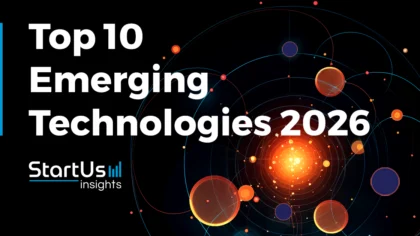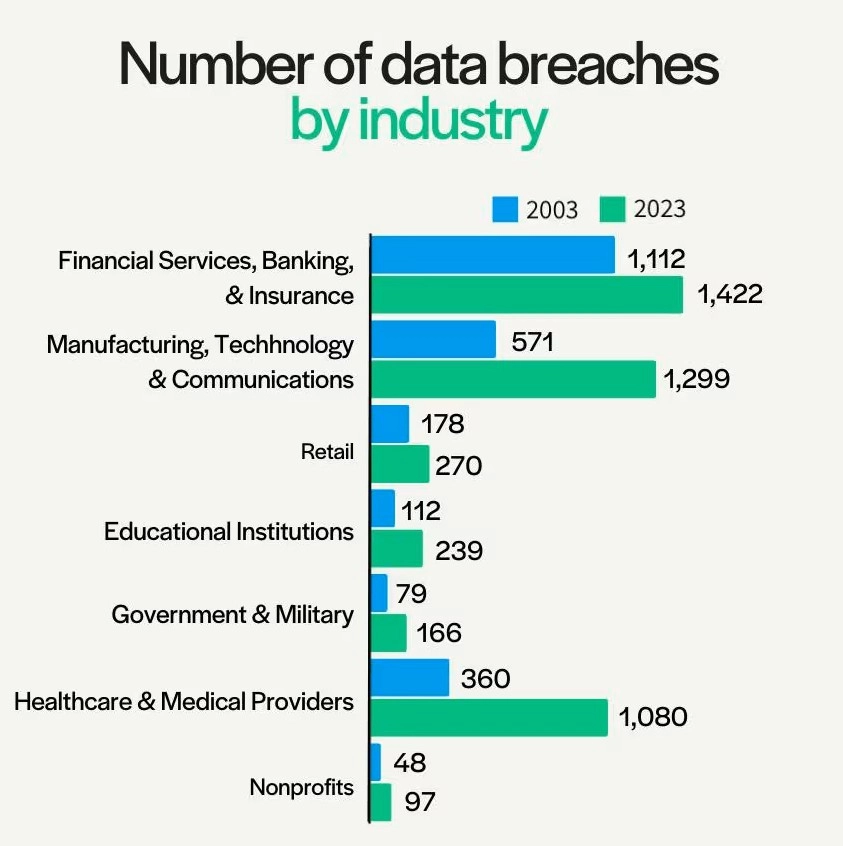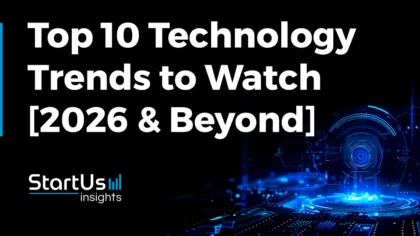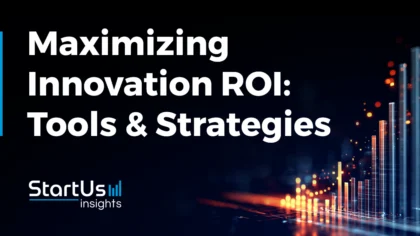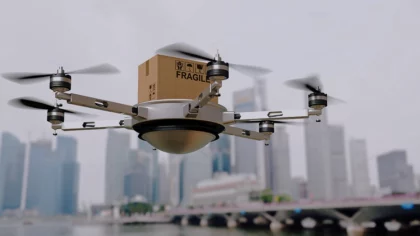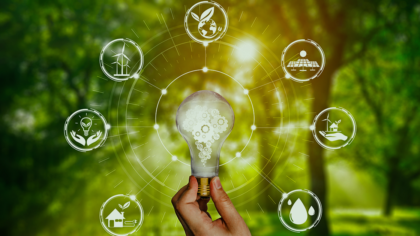Accelerate Productivity in 2025
Reignite Growth Despite the Global Slowdown
Key Takeaways: Which are the 10 Emerging Technologies to Watch in 2026?
- Renewable Energy Advances: Global clean energy investment exceeded USD 2 trillion last year and is set to hit USD 3.3 trillion in 2025, with renewables making up 92.5% of new capacity (IEA). Battery costs fell to an all-time low of USD 115/kWh, while corporate PPAs surged 36% YoY to 15.8 GW. Breakthroughs in fusion and green hydrogen signal next-generation renewables moving from pilot to profit.
- AI Agents & Generative AI: Generative AI is now fully integrated into strategy at 49% of IT CEOs, with global spending projected to reach USD 644 billion in 2025 (Gartner). These systems could deliver USD 2.6-4.4 trillion in yearly economic value (McKinsey). Agentic AI pilots are expected at 25% of enterprises in 2025.
- Advanced Computing: AI-driven power demand is rising 50% annually, and this makes energy-efficient computing critical. Quantum systems are moving toward utility-scale value, with IBM, IonQ, and D-Wave already offering cloud access. Photonic processors deliver data transfer at 114 Tbps with far lower power. With markets projected to reach USD 7.3B (quantum by 2030) and USD 47B (neuromorphic by 2034), these architectures are emerging as the backbone of next-generation computing.
- Brain-Computer Interfaces (BCIs): With nearly 10 million potential implant candidates in the US and 20 million chronic SCI patients globally, BCIs are advancing from labs to clinical and consumer adoption. Neurotech funding hit USD 2.3B in 2024 (led by Neuralink’s USD 650M Series C in 2025) as the global BCI market heads toward USD 6.5B by 2030.
- Cobots & Polyfunctional Robots: Global cobot sales set to hit 735 000 units in 2025, and industrial robot stock surpassed 4.3 million installations. Case studies show cobots boost productivity by 200% in welding and 600% in machine tending. Humanoids like Tesla’s Optimus and Figure AI’s Figure 01 signal a shift to multipurpose automation.
- Spatial Computing & Extended Reality (XR) 2.0: Global XR revenue is projected to hit USD 1.07 trillion by 2030, with AR/VR shipments growing at a 38.6% CAGR through 2029. Productivity case studies show 32% gains in manufacturing training and 25% wiring time reduction at Boeing. Walmart also deployed 17 000 VR headsets for workforce training.
- Cryptography & Digital Trust: Over 1 billion people now use passkeys, covering 13 billion accounts, as enterprises adopt passwordless authentication and zero-trust models, with 81% planning implementation by 2026. Rising threats drive urgency: a single breach costs USD 4.88M, while governments mandate PQC migration (NIST, EU Digital ID Wallets).
- Nanotechnology: Nanotech startups raised USD 1.5B in 2024 across 123 deals to power breakthroughs in graphene, perovskite solar cells, and silicon-rich anodes. Applications span semiconductors, nanomedicine, and clean energy. Nanomedicine alone is projected to reach USD 410B by 2030. Graphene production is expected to reach 9000-170 000 tons annually, while tandem solar cells achieved a record 34.85% efficiency.
- Synthetic Biology & Bio-engineering: The synthetic biology market is projected to hit USD 192.9B by 2034 (28.6% CAGR), fueled by breakthroughs like Casgevy, the first FDA- and NHS-approved CRISPR therapy. Venture capital rebounded to USD 12.2B in 2024, while governments in the US, EU, and South Korea are investing heavily in biofoundry infrastructure.
- 6G & Next-Generation Connectivity: 6G promises terabit-per-second data rates, microsecond latency, and centimeter-level precision while building on 5G Advanced with AI-native, energy-elastic networks. Breakthroughs include NTT’s 280 Gbps terahertz demo and China’s 84 Gbps over 1.26 km, while the EU and US are investing heavily in Hexa-X-II and Next G Alliance initiatives.
- Impact & Use Cases of Emerging Tech:
- Emerging tech in Heavy Industries: 3D printing, cloud computing, and AI have a substantial impact in strengthening the supply chain and improving manufacturing workflows. Asset maintenance, quality control, and remote asset monitoring are the prominent use cases in this segment.
- Emerging tech in Process Industries: They emphasize AI, ML, IoT, and nanotechnology to increase operational efficiency, sustainability, and precision. AI & ML are pivotal in areas like drug discovery and quality control while nanotech delivers high-performance materials for this sector.
- Emerging tech in Light Industries: Technologies like AI, IoT, and 3D Printing are transforming consumer experiences and manufacturing processes. Trend forecasting, connected clothing and smart homes, rapid prototyping, and immersive experiences are major use cases in this sector.
- Emerging tech in Service Industries: This sector leverages technology to personalize customer experiences and enhance customer satisfaction. Primary applications include hyper-personalization, real-time monitoring, transparent transactions, and more.
- Challenges and Ethical Considerations: Compatibility issues with legacy systems and costly upgrades are the major challenges. Safeguarding data privacy and ensuring bias-free technologies is also important.
- Future Outlook: Bridging accessibility gaps of cutting-edge technologies will take center stage. Further, climate-positive practices and human-machine collaboration will evolve.
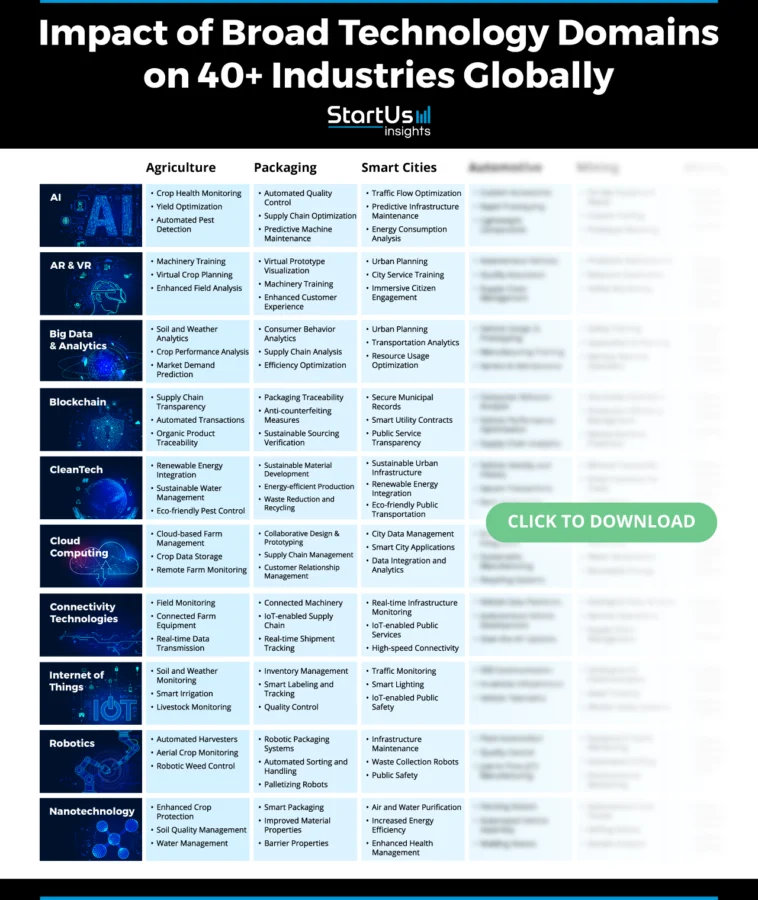
How We Researched and Where this Data is from
- Analyzed our 3100+ industry reports on innovations to gather relevant insights and create a master technology-industry matrix.
- Cross-checked this information with external sources for accuracy.
- Leveraged the StartUs Insights Discovery Platform, an AI- and Big Data-powered innovation intelligence platform covering 4.7M+ emerging companies and over 20K+ technology trends worldwide, to:
- Confirm our findings using the trend analysis tool and
- Find emerging tech companies for “Spotlighting an Innovator” sections.
So, let’s look into the future of technology and see how it impacts every industry, big or small.
1. Renewable Energy Advances: A USD 3.3 T Market
Global investments in clean energy exceeded USD 2 trillion for the first time in 2024. Estimates indicate that they will surpass USD 3.3 trillion in 2025 (of which USD 2.2 trillion will go toward clean technologies). Renewable energy sources accounted for 92.5% of all new power-generation capacity, and indicate an irreversible economic shift away from fossil fuels.
Global Investment in Clean Energy and Fossil Fuels, 2015-2025.

Source: IEA
Further, fusion projects got their first utility-scale power-purchase agreements (PPAs) and battery prices fell to an all-time low of USD 115 per kWh in 2024. These events are proof that next-generation renewables are moving from pilot to profit.
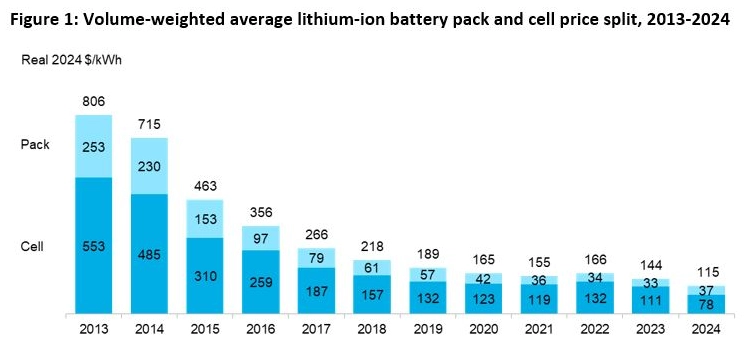
Source: BloombergNEF
IEA predicts that renewable sources will meet about half of the world’s electricity needs by 2030. This will be driven by rapid developments in solar, fusion, batteries, small-modular reactors (SMRs), green hydrogen, and power-to-X (P2X) fuels.
Such renewable energy solutions replace hydrocarbons in power, industry, and transportation. This enables sustainable, molecular, and carbon-free power around the clock at costs comparable to those of today’s fossil fuel substitutes.
Industry Adoption & Economic Impact
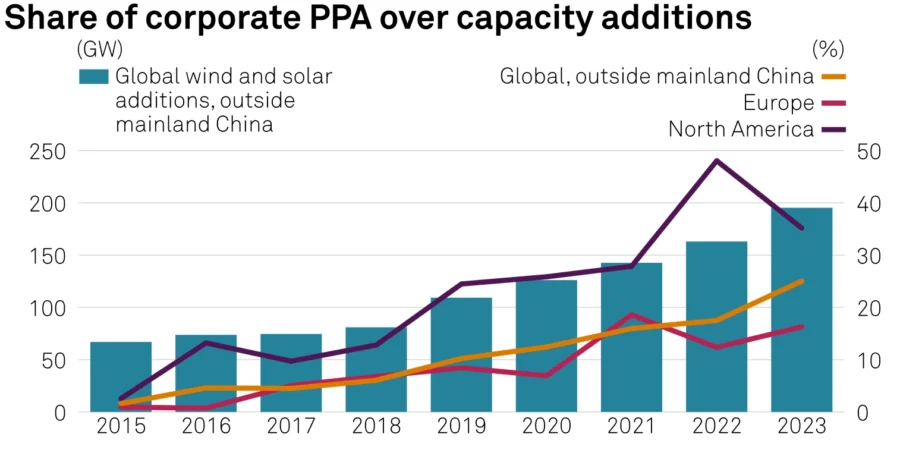
Source: S&P Global
With corporate power-purchase agreements having a 36% year-over-year increase to 15.8 GW in Q1 2024 (according to S&P Global), IEA expects renewables to account for 46% of the world’s electricity generation by 2030.
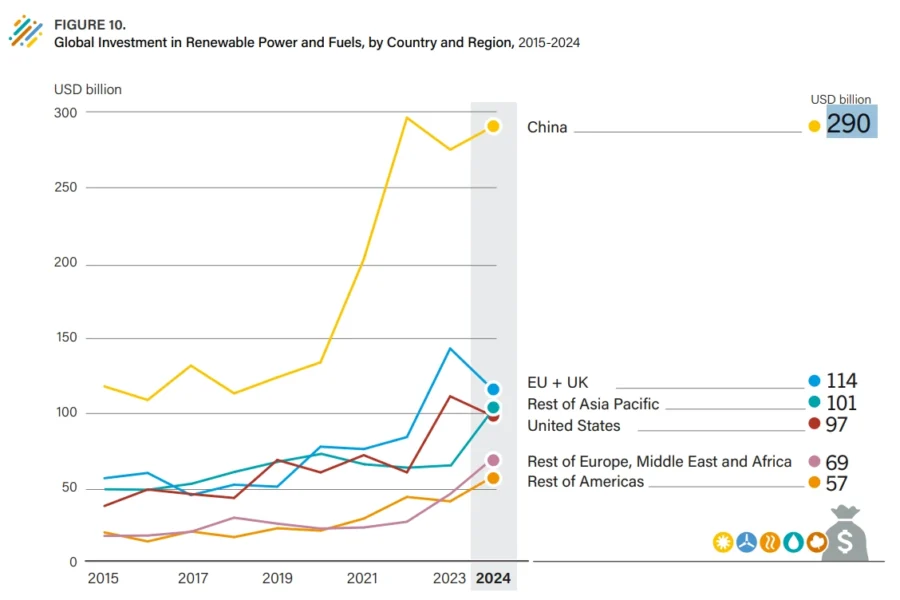
Source: REN21 Global Status Report 2025
Meta alone has over 3.6 GW of solar PPAs, and it is expanding solar generation capacity in Texas (with a recent USD 900 million investment) to power its fleet of data centers.
Additionally, Australia is adding at least 1000 home batteries per day since the new USD 2.3 billion Cheaper Home Batteries program opened for connections on 1 July 2025. Household energy storage installations in the US also surpassed 1.25 GW in 2024 (57% YoY increase).
Global battery manufacturing capacity reached 3.1 TWh in 2024. This was more than 2.5 times the annual demand and created a significant oversupply.
Further, private fusion investment exceeded USD 6 billion last year, and 80% of this went to US companies. NuScale’s VOYGR design also achieved US Nuclear Regulatory Commission certification. X-energy announced a Series C-1 financing round of USD 500 million for SMR development, with main support from Amazon’s Climate Pledge Fund.
According to the IEA, cumulative global SMR investment could reach USD 900 billion by 2050. Such large-scale deployments reduce peak-hour electricity prices while enhancing grid resilience and saving network upgrade costs.
Further, green hydrogen adoption is speeding up. EU refineries are co-firing renewable hydrogen to decarbonize methanol and ammonia production, while India’s National Green Hydrogen Mission aims to produce 5 Mt by 2030.
BloombergNEF forecasts green hydrogen costs to fall from USD 3.74 – 11.70 per kg to USD 1.60 – 5.09 per kg by 2050.
Financial Forecast
- 2030:
- BloombergNEF predicts yearly clean energy investment should reach USD 4.5 trillion per year by 2030 to limit global warming to 1.5 degrees Celsius. This is double the current record investment levels.
- The power-to-X fuels market is predicted to reach USD 645.3 million in the same time frame at a compound annual growth rate (CAGR) of 11.2%, while green hydrogen will grow at a CAGR of 38.5%.
- 2033:
- The lithium-ion battery market is expected to reach USD 194.7 billion in 2025 and USD 426.4 billion by 2033, at a 10.3% CAGR.
Core Technologies Connected to Renewables
- Next-Generation Power Electronics leverage wide-bandgap semiconductors (like SiC and GaN) to increase inverter efficiency. This is crucial for battery and hydrogen systems.
- AI-driven Grid Management optimizes dispatch across distributed batteries to save peak-shaving costs for utilities.
- High-Temperature Superconductors support compact fusion magnets and reduce SMR footprint.
- Solid-State Batteries deliver higher energy density with enhanced fire safety for heavy-duty EV fleets.
- Advanced Electrolysers (particularly PEM and solid-oxide designs) are reducing green hydrogen production costs. This unlocks competitive e-ammonia and power-to-X fuels.
Spotlighting an Innovator: Blue Energy
Blue Energy is a Danish startup that builds modular power plants for modular reactors. It utilizes shipyard manufacturing to reduce nuclear power plant build time and costs. This approach enables the startup to ensure production where a permanent workforce and automated machinery are available.
The company uses light water reactors and passive safety measures. It also submerges the reactor building in a pool to provide additional physical protection and backup cooling. Moreover, this makes the reactor isolated from the rest of the power plant to enable the manufacturing of the turbine hall and other nuclear systems in the shipyards themselves.
As a result, the startup enables centralized manufacturing while keeping a small plant footprint. It also eliminates the heavy logistics usually associated with power plants.
2. AI Agents & Generative AI: Delivering USD 4.4 T
49% of IT CEOs report that generative AI is now “fully integrated” into core business strategy. Moreover, companies jointly invested approximately USD 45 billion in venture capital funding last year.
These efforts showcase that generative AI has gone from being a novelty to a necessity, and enterprise trials are quickly developing into full-scale implementations.
According to Deloitte, 25% of all gen-AI users will launch agent AI pilots or proof of concepts in 2025 alone.
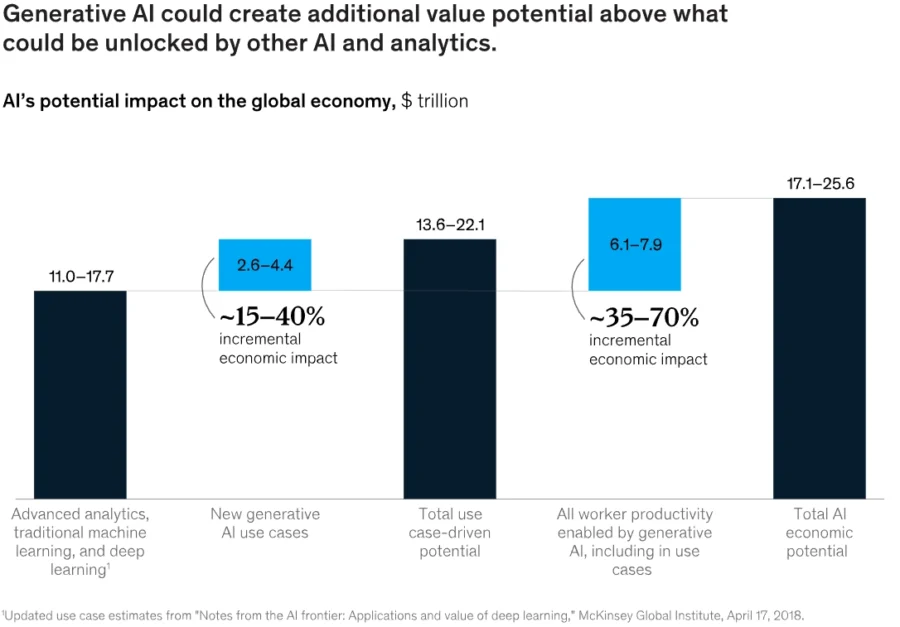
Source: McKinsey
McKinsey predicts these systems might deliver USD 2.6 – 4.4 trillion in yearly economic value (nearly the GDP of Germany) when they advance beyond text creation into reasoning, multimodal perception, and closed-loop task execution.
Generative AI models create new content like text, code, images, video, protein sequences, and more. They learn the underlying patterns of vast datasets. AI agents add a planning layer along with generative AI to receive goals, break them into subtasks, call the right models or APIs, and iterate until they hit success criteria.
This way, agents shift AI from “copilot” to “co-worker.” They handle complex, multistep workflows like drafting legal contracts, debugging code, or orchestrating supply chain responses without human prompts.
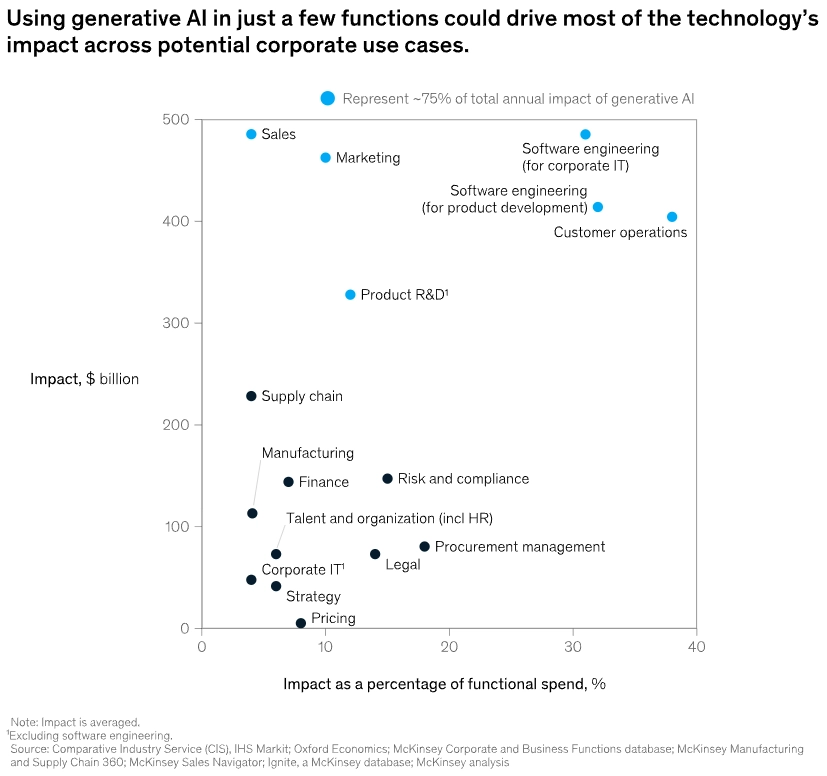
Source: McKinsey
OpenAI launched GPT-5 in August 2025. This new model emphasizes advanced reasoning. Likewise, Meta’s Llama 4 Maverick introduces 400 billion-parameter sparse-expert architecture with native multimodality.
Open-source stacks such as LangChain, AutoGen, and IBM’s tool-based agents (routing logistics or IT tickets) enable enterprises to assemble domain-specific agents in weeks. There are advances in local models as well, like the recent Qwen3-Coder with 480B parameters.
Emerging ISO 42001 and EU AI Act compliance modules are also now bundled with leading generative AI platforms to lower legal risk and accelerate procurement.
Industry Adoption & Economic Impact
Gartner forecasts that generative AI spending will reach USD 644 billion in 2025. Moreover, private investment in generative AI reached USD 33.9 billion last year. This was an 18.7% year-on-year jump.
AI startups raised USD 3.7 billion across 127 funding rounds in April 2025 alone. This underscores sustained capital inflows.
56% of global enterprises have already built genAI training programmes for staff, with another 19% planning to launch in 2025. Additionally, nearly half of CIOs surveyed by PwC rank AI investments as the most critical decision of their careers. This demonstrates executive-level urgency.
PwC’s 2025 Jobs Barometer links AI exposure to a 25% wage premium in data-centric roles YoY. This signals demand for “AI-augmented” talent rather than broad displacement.
IoT Analytics estimates that Accenture’s GenAI services revenue alone increased 390% from the previous year by the end of 2024.
Further, Gartner predicts that agentic AI will make at least 15% of daily work decisions by 2028. It also expects that 33% of enterprise software applications will include agentic AI by 2028.
AI’s Impact on the Workforce
Financial Forecast
- 2028:
- According to IDC, generative systems will account for 32% of the USD 632 billion in overall AI spending.
- Generative AI revenue to surpass USD 1 trillion (a jump from USD 45 billion in 2024).
- 2033:
- The autonomous agents market is expected to reach USD 70.59 billion at a CAGR of 42.12%.
Core Technologies Connected to Generative & Agentic AI
- Large Language & Multimodal Models: Foundation models like GPT 4.5 and Llama 4 supply the generative core and distill hundreds of billions of parameters into instruction-tuned outputs.
- Retrieval-Augmented Generation (RAG): Vector databases (e.g., Pinecone, Chroma) inject real-time knowledge into prompts to improve factual accuracy and compliance.
- Domain-Specific Accelerators: Next-generation GPUs and AI ASICs (NVIDIA Blackwell, Google TPU v6) boost training throughput. This reduces model-ops cost curves.
- Policy & Audit Layers – Emerging AI governance platforms embed bias-detection, audit logs, and red-team simulations to align deployments with ISO 42001 and EU AI Act mandates.
Spotlighting an Innovator: Polaron
Polaron is a UK-based startup that builds an AI-powered material design solution. Its machine learning algorithms analyze microscopy images to characterize and optimize materials faster and accurately. They extract volume fraction particle pathologies and identify particle cracking anomalies.
Further, the solution leverages microstructural data. Its exploration module further generates microstructures with new properties, like volumes with different phase surface areas and graded phase volume fractions. This allows researchers to rapidly test multiple potential microstructure designs and identify the best material manufacturing routes or explore complex multi-objective design challenges.
3. Advanced Computing: Neuromorphic | Quantum | Photonic | Hybrid
As businesses deal with high energy consumption due to increased demand for AI and data centers, energy-efficient computing without losing performance is becoming critical. Neuromorphic chips are already significantly more efficient than GPUs in sensor-fusion workloads. These technologies create an advanced computing stack to deliver budget reductions and performance benefits.
Quantum-classical clusters are getting closer to economically viable “utility” value, while photonic processors transport data inside data centers at the speed of light. Photonic chips utilize light instead of electrons to remove I/O bottlenecks, and quantum machines use superposition to search vast combinatorial spaces.
AI-related electricity consumption is expected to increase by 50% annually from 2023 to 2025. This necessitates a shift to architectures that provide more computation per joule. Such technologies allow for larger models, quicker simulations, and real-time decision-making without destroying the environment or the financial sheet.
University of California researchers integrated quantum dot lasers directly on silicon to mass-produce photonic processors. In terms of neuromorphic computer innovations, Intel’s Loihi 2 delivers up to 10x the throughput of its predecessor and demonstrated 100 times more CPU energy efficiency in real-time sensor fusion.
Further, IBM’s fault-tolerant roadmap targets million-qubit machines by 2029, while startups IonQ and D-Wave already sell cloud access. Lightmatter’s Passage chip, backed by USD 850 million in VC funding, also pipes optical signals between AI accelerators for a 114 Tbps bandwidth at a fraction of GPU power.
Industry Adoption & Economic Impact
With 127 and 433-qubit utility-scale systems currently available in IBM’s cloud and a 1000-plus-qubit processor planned for 2027, industries are already running “quantum-utility” workloads. To ensure sovereign access, IBM Europe is creating a special “Quantum Pillar” in the EuroHPC budget.
Private and public investors poured nearly USD 2 billion into quantum technology startups in 2024. This represents a 50% increase from USD 1.3 billion in 2023. Moreover, quantum computing companies generated a revenue of USD 650-750 million last year and are expected to reach USD 1 billion by the end of 2025.
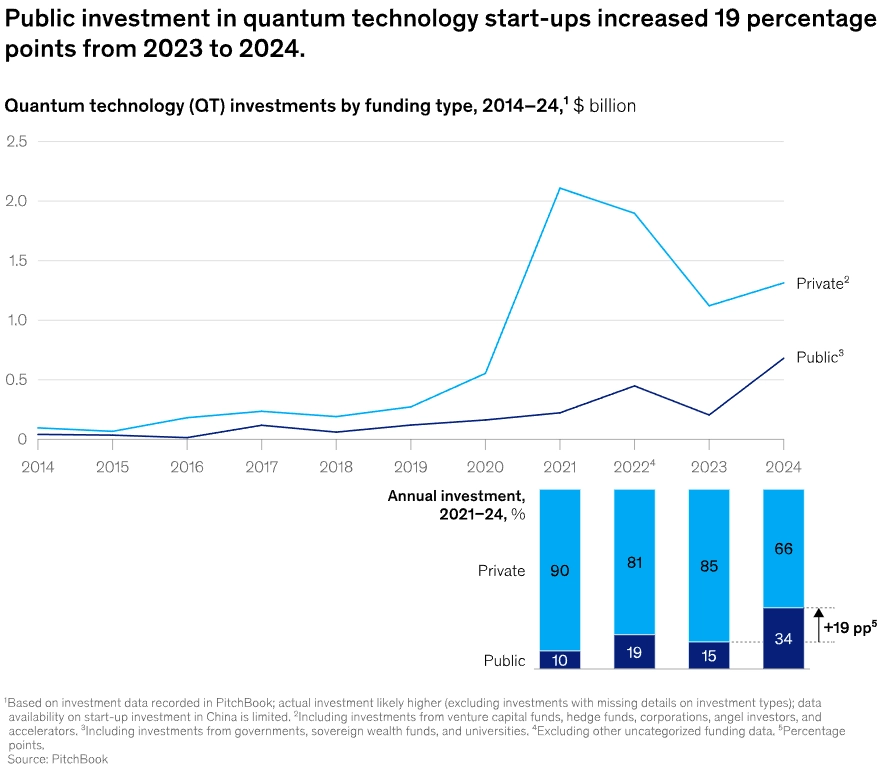
Source: McKinsey’s Quantum Technology Monitor, 2025
When compared to traditional AI accelerators, Mercedes-Benz reports 90% energy savings in autonomous driving perception tasks. This establishes the technology as a crucial enabler of Level-4 autonomy.
Intel has shipped more than 8 million photonic integrated circuits (PICs) since 2016, and photonic integrated circuit transceivers are expected to achieve 1.6 Tbps speeds by 2025-2026.
Amazon Braket Hybrid Jobs service combines GPU simulations and quantum circuits to enable developers to iterate without experiencing hardware downtime. Additionally, hyperscale operators leverage silicon-photonic interconnects to increase AI bandwidth.
Financial Forecast
- 2030:
- The global quantum-computing market will climb to USD 7.3 billion by 2030 at a 34.6% CAGR.
- Photonics shows a bifurcated picture: the broad photonics sector edges toward USD 1.3 trillion by 2030 at 4.8% CAGR, while high-value silicon-photonic devices will grow nearly 25.8% annually to USD 8.13 billion.
- 2032:
- Neuromorphic revenue should expand from roughly USD 0.21 billion in 2025 to USD 1.3 billion in 2032 (29.5% CAGR).
- 2034:
- The neuromorphic computing market is expected to reach USD 47.31 billion at a 21.23% CAGR.
Core Technologies Connected to Advanced Computing
- Silicon Photonics & Co-Packaged Optics: Integrate lasers with CMOS to move data across boards at picosecond latencies to solve AI cluster bottlenecks.
- Spiking Neural Networks & Event-Based Sensors: Pair neuromorphic logic with event cameras to reduce perception latency by an order of magnitude for autonomous platforms.
- Cryogenic & Error-Mitigation Toolchains: Surface-code qubits, bias-drifting controls, and Fire Opal error suppression on cloud QPUs improve fidelity enough for early ROI.
- Hybrid Orchestration Frameworks: AWS Braket, Dell HQCC blueprints, and open-source Qiskit Runtime distribute workloads between CPUs, GPUs, and QPUs.
- Optical Neural Networks (ONNs): Metasurface arrays with millions of photonic neurons push GPU efficiency for inference at the edge.
Spotlighting an Innovator: Aqarios
Aqarios is a German company that enables businesses to build, benchmark, and deploy quantum-powered optimization applications. The startup’s platform allows businesses to access proprietary algorithms for real-world problems, build and solve optimization models hardware-agnostically, and explore quantum, hybrid, and classical algorithms.
This solution allows businesses and researchers to mitigate in-house development and associated costs while accelerating quantum application deployments.
4. Brain-Computer Interfaces: 30 M Potential Customers
Globally, an estimated 0.9 million new spinal-cord injuries occurred in 2019, and 20 million people live with chronic SCI – key target users for medical BCIs. Further, Morgan Stanley counts nearly 10 million potential BCI implant candidates in the United States across paralysis, ALS, stroke, and related conditions.
With the recent developments, brain-computer interfaces are progressing quickly from lab demonstrations to consumer-grade neural input for augmented reality glasses, wrist-worn wearables, and regulated medical devices.
While competitor Synchron’s Stentrode has reached its US safety objectives, Neuralink’s human studies now allow paralyzed participants to browse, game, and draw with their thoughts.
At the same time, researchers developed a non-invasive surface-electromyography (sEMG) wristband that enabled users to achieve a 20 words per minute typing speed. Such solutions hint at mass-market human-machine symbiosis opportunities.
BCIs also leverage AI decoders to translate electrical, optical, and hemodynamic signals from the brain or peripheral neural pathways to control external devices in real time. This technology will enable hands-free control layers for consumer, military, and industrial computing while restoring communication, movement, and autonomy for the millions of individuals living with paralysis globally.
Neuralink’s 128-thread N1 chip now supports wireless cursor control, text entry, and gaming for quadriplegic users. Further, software updates will compensate for partial thread retraction without repeat surgery.
Synchron’s stent-based electrode, deployed via jugular vein, has allowed patients to text, email, and control Amazon Alexa hands-free in home environments. Further, a code-modulated visual evoked potentials (cVEP)-based visual speller enabled ALS patients to reach 10 characters per minute.
Industry Adoption & Economic Impact
The early adopters of BCIs are hospitals and research facilities. Following a single electrode-thread learning phase, Neuralink’s human participants were able to point and click without hand movement. This exhibits clinically meaningful performance for patients with spinal cord injuries.
With six ALS participants experiencing zero major device-related adverse events, Synchron’s COMMAND study in the US met its main goal and opened the door to pivotal studies.
Automobile manufacturers are also testing EEG-based driver fatigue detection outside of the medical field to reduce drowsy-incident rates on long-haul fleets.
Venture capital investment in neurotech totalled USD 2.3 billion across 129 deals in 2024. More recently, Neuralink raised USD 650 million in its June 2025 Series C.
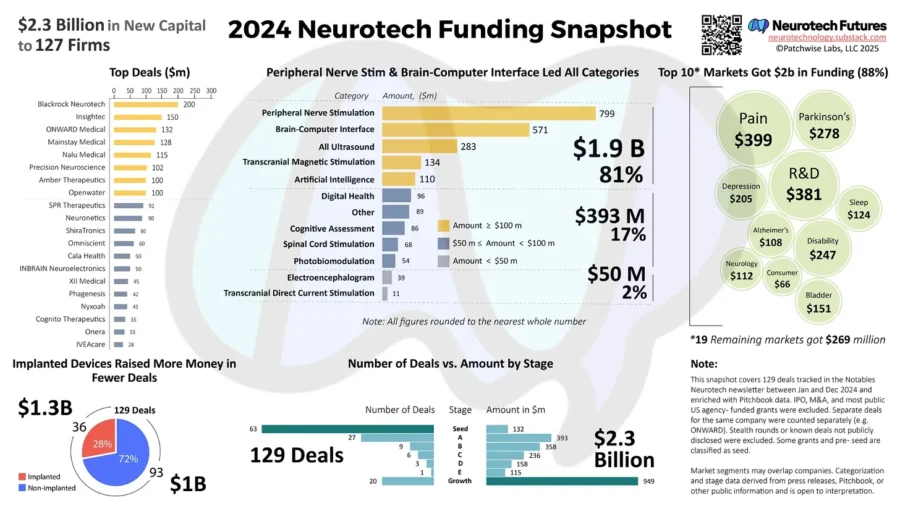
Source: Neurotech Futures’ 2024 Funding Snapshot. https://rb.gy/fic5so
Further, Precision Neuroscience raised USD 102 million in December 2024 for its 1-micrometer-thick Layer 7 cortical array. This brought its total funding to USD 155 million. Similarly, Blackrock Neurotech received USD 200 million in crypto cash from Tether to scale clinical implants.
The US Defense Advanced Research Projects Agency is also funding six university-industry teams under its Next-Generation Nonsurgical Neurotechnology (N3) program to mature wearable, soldier-friendly BCIs.
Evolution of Brain-Computer Interface Publications
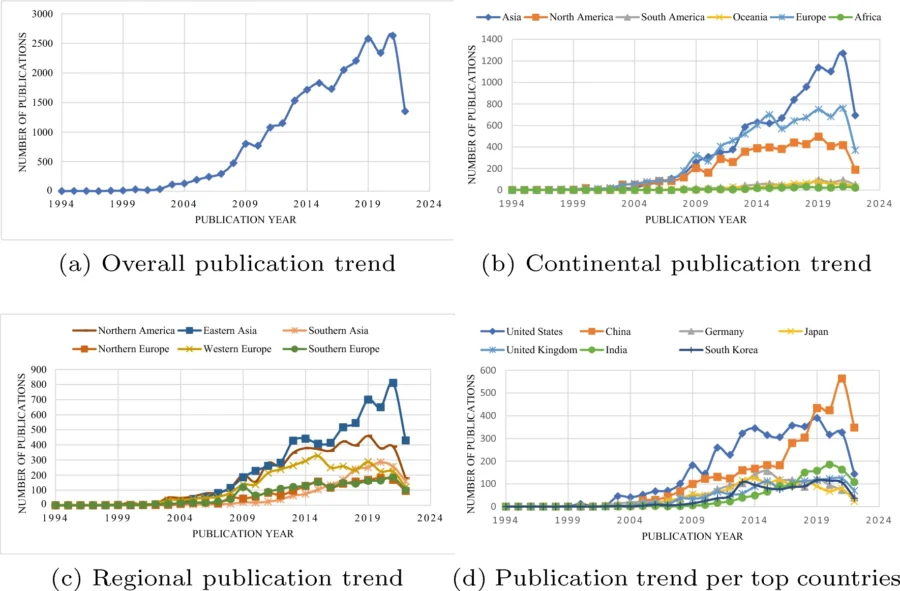
Maiseli, B., Abdalla, A.T., Massawe, L.V. et al. Brain-computer interface: trend, challenges, and threats. Brain Inf. 10, 20 (2023). https://doi.org/10.1186/s40708-023-00199-3
Financial Forecast
- 2030:
- Grand View Research projects the global BCI market will reach USD 6.52 billion at an 18% CAGR, propelled mainly by medical neuroprosthetics and rehabilitation devices.
- North America already leads the market with USD 970.9 million in annual BCI revenues and will maintain 17.9% compound growth.
- 2034:
- The market is forecasted to reach USD 12.4 billion by 2034 at a 17.35% CAGR.
Core Technologies Connected to BCIs
- High-Channel Neural Implants: Sub-millimetre flexible electrode threads (Neuralink, Paradromics) offer thousands of recording sites for richer motor and sensory decoding.
- Endovascular Electrodes: Synchron’s Stentrode leverages nitinol stents to place electrodes inside cortical veins. This eliminates open-skull surgery and expands addressable patients.
- Surface EMG & sEMG AI Decoders: Meta’s Orion wristband pairs advanced electromyography with transformer models to separate intent-to-move signals from ambient noise.
- Edge-Optimized Neural DSPs: On-implant application-specific integrated circuits (ASICs) compress raw spike data to reduce telemetry bandwidth and enable wireless operations.
- Biocompatible Power & Materials: Ultrathin bio-silicone encapsulation and induction-charge telemetry extend implant lifetimes, while graphene electrodes improve signal-to-noise ratios.
Spotlighting an Innovator: Possibility Neurotechnologies
Possibility Neurotechnologies is a Canadian company that develops Think2Switch, a device that converts brain signals into usable commands. It combines a brain-sensing headset and proprietary software to control up to four separate switch-adapted or electrical devices. This allows users to control real-world objects using their thoughts.
5. Cobots & Polyfunctional Robots: Boost Productivity by 200%
Due to the convergence of labor shortages and rising automation demand, service robot exports are increasing. As a result, pilot projects are quickly transitioning into full-scale implementations. They increase throughput and open up completely new revenue sources for early adopters.

Source: Market.us Scoop
Polyfunctional and humanoid robots switch tasks on the fly to replace today’s single-purpose machines with adaptable, AI-driven companions while collaborative robots (cobots) work safely next to people. Gartner lists polyfunctional robots among the top tech trends.
Cobots share workspaces with humans using force-limited arms, 3D vision, and AI safety layers. Polyfunctional robots, on the other hand, add real-time learning and modular tooling, while humanoids add bipedal mobility.
IFR case studies report that cobots boost production by 200% on welding and 600% on machine tending.
Tesla’s Optimus program targets a few hundred units by the end of 2025 and is aiming for mass production in the coming years, according to Elon Musk’s latest projection. Figure AI is also receiving USD 1.5 billion in funding at USD 39.5 billion valuation to scale its Figure 01 general-purpose robot.
Industry Adoption & Economic Impact
There were over 541 000 industrial robots installed worldwide in 2023, and the total operating stock to 4.3 million units in 2024. As businesses take advantage of their lower integration costs, cobot sales are expected to reach 735 000 units this year.
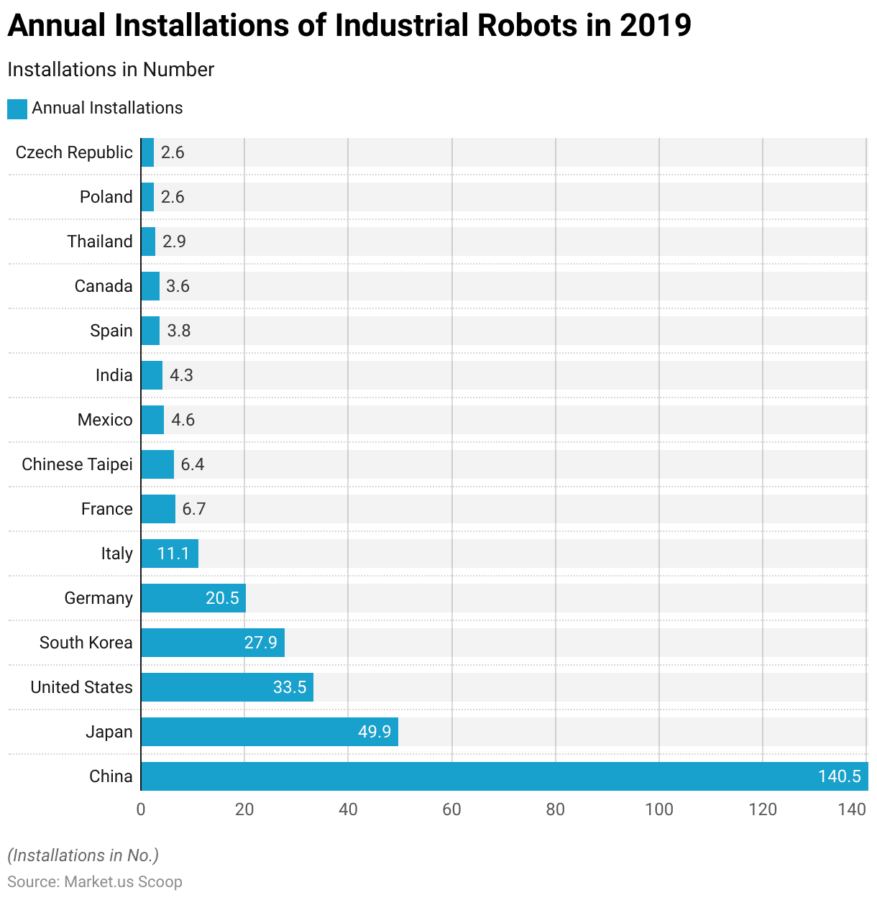
Source: Market.us Scoop
Universal Robots alone has shipped over 75 000 units cumulatively. Outside of manufacturing, sales of professional service robots increased by 30% to over 205 000 units due to the healthcare, retail, and logistics industries.
Logistics’ interest in legged platforms was highlighted when Amazon’s warehouses started conducting extensive testing of Digit, a mobile manipulation robot from Agility. Digit walks within human racks and unloads totes.
Schaeffler Group also agreed to purchase Agility’s humanoids for deployment in 100 plants worldwide by 2030.
Financial Forecast
- 2029:
- China accounts for more than half of global cobot shipments since 2023, and the quantity is expected to reach almost 70 000 units by 2029.
- 2030:
- The cobots market is set to reach USD 11.64 billion by 2030 at a 31.6% CAGR.
- Humanoid robots are expected to reach a market value of USD 15.26 billion.
- Cobots are projected to generate approximately USD 2.5 billion in revenues globally.
- 2050:
- Morgan Stanley is eyeing a USD 5 trillion market for humanoids.
Core Technologies Connected to Advanced Robotics
- Modular End-Effectors & Tool-Changers: Quick-swap grippers, sanding heads, and screwdrivers give one arm many jobs for polyfunctionality.
- AI Motion-Planning & Vision: Deep learning perception stacks allow safe collaboration and dynamic task re-planning in mixed human-robot spaces.
- Lightweight, Force-Limited Actuators: Integrated torque sensors meet ISO/TS 15066 safety limits to enable cage-free deployment next to workers.
- Edge-to-Cloud Robot Operating Systems: Containerized apps and over-the-air updates (e.g., Digit’s Skill Library) unlock continuous capability expansion.
- High-Density Batteries & Drive Electronics: Advances borrowed from EVs power mobile manipulators and humanoids for full-shift operation.
Spotlighting an Innovator: NEXTUP ROBOTICS
NEXTUP ROBOTICS is an Indian startup that builds cobots and a high-speed industrial robotic arm. The cobots support up to 5 Kg of payloads as well as feature 6-axis degrees of freedom, 950 mm reach, sub-millimeter repeatability, and computer vision.
Similarly, the robotic arm supports up to 7 Kg of payloads and features 6-axis degrees of freedom and 1500 mm reach. The robots support operations like pick and place, power coating, machine tending, inspection, and welding. They find applications in industries like glass manufacturing, automotive manufacturing, as well as grinding and cutting units.

6. Spatial Computing & XR 2.0: A 349 B Market
Extended reality and spatial computing are evolving from niche demonstrations to board-level priorities. For instance, AR and VR headset shipments grew by 10% in 2024 and are now expected to increase at a 38.6% CAGR through 2029, while global XR revenue is expected to reach USD 1.7 trillion by 2030.
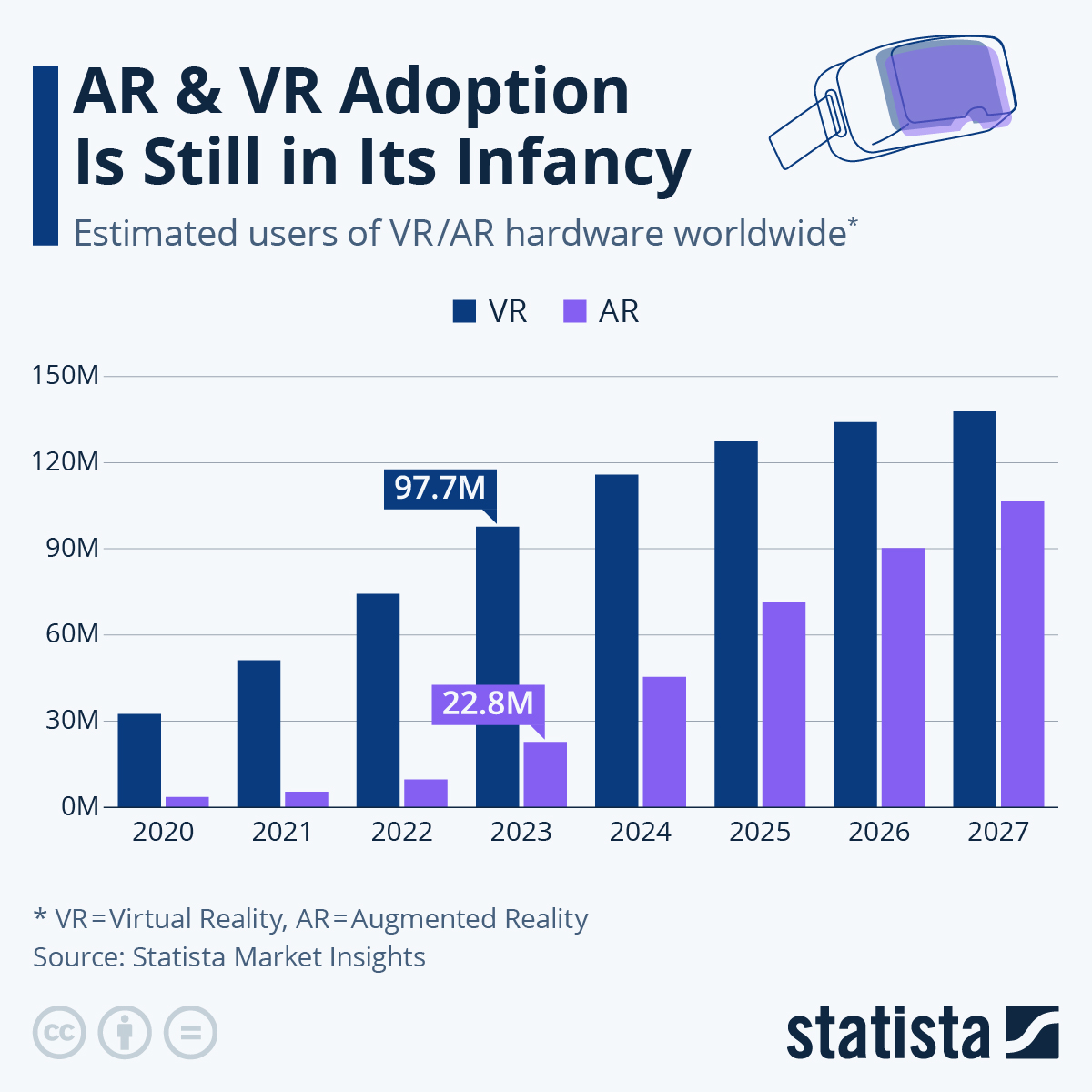 You will find more infographics at Statista
You will find more infographics at Statista
As immersive workflows replace 2D screens, companies like Boeing and Walmart report productivity benefits. Flagship gadgets like Apple Vision Pro and Meta Quest 3/3 S are changing user expectations.
With the developments in processors, optics, and 5G/edge, XR 2.0 has the potential to drastically enhance design, training, field support, and customer interactions.

Source: Enterprise Apps Today’s Virtual Reality Statistics and Facts 2024
By combining permanent 3D digital content with a real-world environment, spatial computing enables people to engage with information using their hands, eyes, and voice.
For example, Apple refers to its Vision Pro as its first spatial computer. It highlights an infinite canvas without a window that views programs as position-aware objects in real space. Further, always-on, room-scale interactions are feasible with advances in inside-out tracking, low-latency rendering, and cloud synchronization.
A PwC study found that XR-assisted training increased manufacturing productivity by 32% and reduced error rates by 25%.
Industry Adoption & Economic Impact
After two declining years, global shipments of AR/VR headsets increased by 10% last year due to demand during the holiday quarter and new competitors. IDC forecasts that MR headset shipping will reach approximately 7.7 million units by the end of this year.
With the Quest 3S, Meta is expanding access to mixed reality (MR) features while retaining its dominant market share of over 77% to reach 84% in Q4 2024.
Historical AR/VR Market Share

Source: IDC’s AR & VR Headsets Market Insights, 2025
After Meta, Apple had 5.2% market share, followed by Sony with 4.3% and ByteDance capturing 4.1% in 2024.
Further, by using AR headsets to overlay interactive 3D diagrams, Boeing reduced wiring production time by 25% and reduced mistake rates to almost nil on the factory floor.
To train one million associates across the US, Walmart supplied 17 000 VR headsets. This improved customer service ratings and accelerated onboarding.
Apple Vision Pro introduced eye, hand, and voice-controlled spatial computing, and Meta’s Quest 3 added color passthrough and mixed reality at half the price of prior pro models.
Qualcomm’s Snapdragon XR2+ Gen 2 platform now delivers 15% higher GPU and 20% higher CPU max frequency than XR2 Gen 2 versus the prior generation. It enables higher-fidelity MR in untethered headsets.
Adoption of open standards (like the Khronos OpenXR API) is also unifying runtime layers across vendors. This reduces development costs and accelerates enterprise migration.
Financial Forecast
- 2028:
- IDC’s Worldwide Spending Guide expects global AR/VR hardware, software, and services to exceed USD 77.5 billion in 2028, led by discrete manufacturing, retail, and healthcare.
- AR and VR shipments will reach 22.9 million units at a CAGR of 36.3%.
- 2030:
- Grand View Research expects the XR market to reach USD 1.07 trillion by 2030 at a 32.9% CAGR.
Core Technologies Connected to Spatial Computing
- Micro-Display Evolution: TrendForce predicts micro LED will capture 44% of AR glass display market by 2030. This technology delivers higher brightness and longer lifetime.
- Waveguide & Optics: Lumus and other suppliers are doubling optical efficiency, reducing lens stacks, and offering cleaner color uniformity for lightweight, sunglasses-style wearables.
- Edge & 5G Streaming: Low-latency 5G and edge compute remove thermal limits on headsets. This is a key driver for XR adoption.
- Spatial Anchors & SLAM: visionOS and Lightship VPS combine on-device LiDAR and cloud maps to maintain sub-centimetre tracking. This enables persistent collaborative workspaces.
- Haptics & Perception AI: Startups are integrating ultrasonic mid-air haptics and AI-based hand tracking to enable tool-free interaction. Qualcomm’s Edge AI Box also accelerates such workloads at the edge.
Spotlighting an Innovator: ScannedReality
ScannedReality is a German company that offers a volumetric video solution for authentic spatial recording, editing, and playback. It allows users to record fully spatial video that can be viewed from any angle.
The solution enables businesses to produce immersive content for XR headsets, capture and replay motion sequences in 3D, and more. It finds applications in the advertising, AI, research, and media sectors.
7. Cryptography & Digital Trust: Safeguarding a USD 100 T Economy
More than 400 million Google accounts currently use passkeys instead of passwords to log in. Trusted digital rails are essential to every industry, as a single breach costs an average of USD 4.88 million and quickly loses brand equity.
 You will find more infographics at Statista
You will find more infographics at Statista
Over 1 billion individuals have activated at least one passkey and can access 13 billion accounts with it, according to FIDO Alliance’s 2024 data. Further, GitHub achieved a 95% two-factor-auth opt-in rate after introducing passkeys.
Post-quantum cryptography (PQC), zero-trust, decentralized identities, and confidential computing are some of the next wave of cryptography and governance advances that make trust future-proof and scalable.
Cryptography and digital trust solutions feature a stack of identification frameworks, governance standards, hardware roots-of-trust, and algorithms that confirm who can view or change data. They replace phishable passwords with passkeys, upgrade ciphers before the arrival of quantum computers, and substitute continuous verification for perimeter defenses.
According to Entrust’s 2024 PKI and PostQuantum Trends Study, 61% of CISOs plan to adopt PQC within five years, yet only 41% have begun preparations.
The image below represents a geographic breakout of who answered “Yes” to the question “Does your organization plan to migrate to PQC within the next five years?”
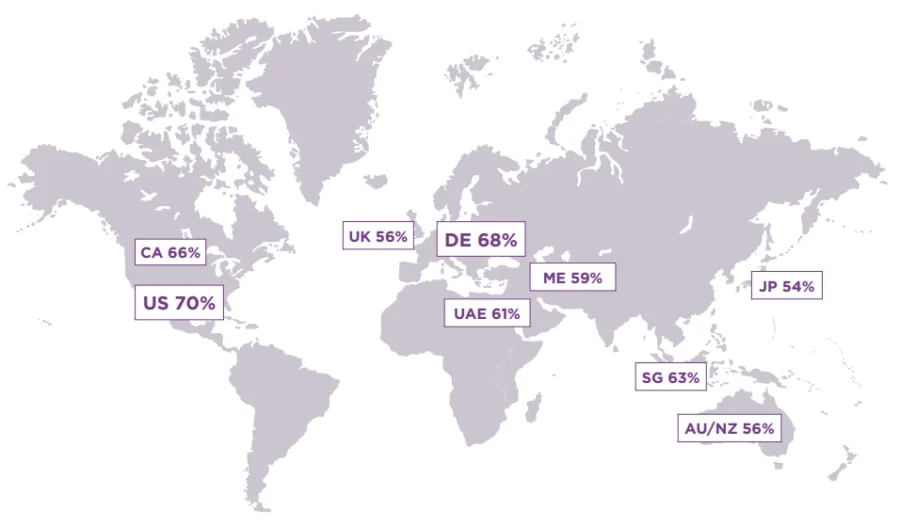
Source: Entrust
Industry Adoption & Economic Impact

Source: Zoho Directory
81% of big organizations plan to implement zero-trust by 2026. This indicates that enterprise commitment is increasing. Moreover, 96% of security decision-makers prioritize zero-trust, and 76% say deployments are already underway.
Gartner expects 60% of enterprises to treat zero-trust as their default security baseline by 2025. However, only 8.6% of the world’s top 1 million websites support hybrid PQC today, versus 42% among the top 100 sites. Banking is furthest behind, as only 3% of bank websites enable PQC safeguards.
The US Office of Management and Budget directed all “agencies to comply with National Security Memorandum 10 (NSM-10), on Promoting United States Leadership in Quantum Computing While Mitigating Risk to Vulnerable Cryptographic Systems (May 4, 2022).”
At the same time, the EU Digital Identity Regulation mandates that each member state issue an EU Digital Identity Wallet by 2026.
Passkey awareness has increased from 39% in 2022 to 57% of users in 2024, according to FIDO Alliance surveys. Moreover, one in four users activates them whenever feasible. This indicates widespread adoption.
Apple, Google, and Microsoft have also implemented passkeys in iOS 17, Android 15, and Windows 11. This enables cross-device sign-ins without passwords.
Additionally, NIST released its first three PQC standards last year. This is the largest crypto upgrade since AES.
Financial Forecast
- 2028:
- Confidential computing, propelled by AI privacy needs, is on track for a 62.1% CAGR to nearly USD 59.4 billion.
- 2030:
- The PQC market will reach USD 7.82 billion by 2030 at a 37.6% CAGR.
- 2032:
- Zero-trust revenues are set to rise at a 16.6% CAGR to reach USD 96 billion under bullish scenarios.
- ABI Research expects the overall confidential computing revenue to reach USD 160 billion at a CAGR of 44%.
Core Technologies Connected to Digital Trust & Cryptography
- Post-Quantum Algorithms: Lattice-based ML-KEM and ML-DSA plus hash-based SPHINCS-+ replace RSA/ECDSA. They safeguard data against future quantum decryption.
- Hardware Roots-of-Trust: TPM 2.0, Apple Secure Enclave, and Microsoft Pluton embed cryptographic keys in chips to ensure zero-trust attestations.
- Confidential Computing Enclaves: Intel SGX, AMD SEV-SNP, and ARM CCA isolate code and data at runtime. This enables AI model-as-a-service without exposing IP.
- Decentralized Identifiers & Verifiable Credentials: W3C DID/VC standards power EU Digital Identity Wallets and cross-border credential exchange to eliminate central honeypots.
- FIDO2 Passkeys & WebAuthn: Cryptographic key pairs bound to devices provide phishing-resistant login flows that are 50% faster than passwords and already favoured by major platforms.
Spotlighting an Innovator: Venari Security
Venari Security is a UK-based startup that develops a platform that increases visibility into the encrypted attack surface. This ensures regulatory compliance and privacy adherence. The platform combines live traffic intelligence, active asset discovery, and AI-powered prioritization to better understand the transport layer security (TLS) landscape.
The platform also enables automated quantum-vulnerable algorithm identification, offers cryptography bill of materials (CBOM) from live traffic analysis, and maps multi-framework compliance. This enables real-time compliance drift detection, PQC-readiness, and TLS-first crypto agility for businesses.
8. Nanotechnology: Raised 1.5 B in 2024
Nanotechnology is maturing into a cross-industry growth engine. Preqin data shows nanotech start-ups raised $1.5bn across 123 deals in 2024, up on the $1.1bn raised in 148 rounds in 2023. Over 6500 investors have engaged in nanotechnology, contributing to 12 000+ closed funding rounds.
Recent examples include India’s Vimano raising USD 3 million from Ankur Capital for clean energy membranes and VSParticle securing EUR 6.5 million in an A2 extension led by NordicNinja for nanoparticle synthesis platforms. Additionally, Summit Nanotech closed a USD 25.5 million deal for its direct lithium extraction technology.
Further, the sector enabled breakthrough materials from graphene and MXenes to perovskite solar layers and silicon-rich battery anodes.
Nanotech manipulates materials at scales of 1-100 nm, where surface and quantum phenomena predominate. Tailoring material attributes in this scale enables super-strong composites, ultra-efficient catalysts, customized drug carriers, and transistors with billions of gates.
Nano-enabled goods are becoming essential in semiconductors, health, and clean energy devices due to declining fabrication costs, AI-accelerated materials discovery, and pressing decarbonization objectives.
Industry Adoption & Economic Impact
As lipid-nanoparticle mRNA vaccines, siRNA treatments, and nano-imaging agents grow, the nanomedicine market is expected to surpass USD 410 billion by 2030.
An example from the electronics industry is IBM’s 2 nm nanosheet transistor technology that packs 50 billion devices on a single chip and extends Moore’s Law for AI workloads.
In the field of renewable energy, silicon-anode startups were expected to have drawn over USD 4.5 billion to increase EV range and enable 15-minute charge. Perovskite-silicon tandem solar cells also achieved 34.85% certified efficiency this year, and they offer lighter, less expensive modules.
This growth is reflected in venture capital as well. Nanotech startups raised USD 1.5 billion in 123 deals in 2024, up from USD 1.1 billion the year before.
Further, the EU Graphene Flagship expects multiple 2025 product launches in composites, sensors, and EMI shielding. This will increase market penetration by the end of the year.
EU Graphene Flagship Technology and Innovation Roadmap
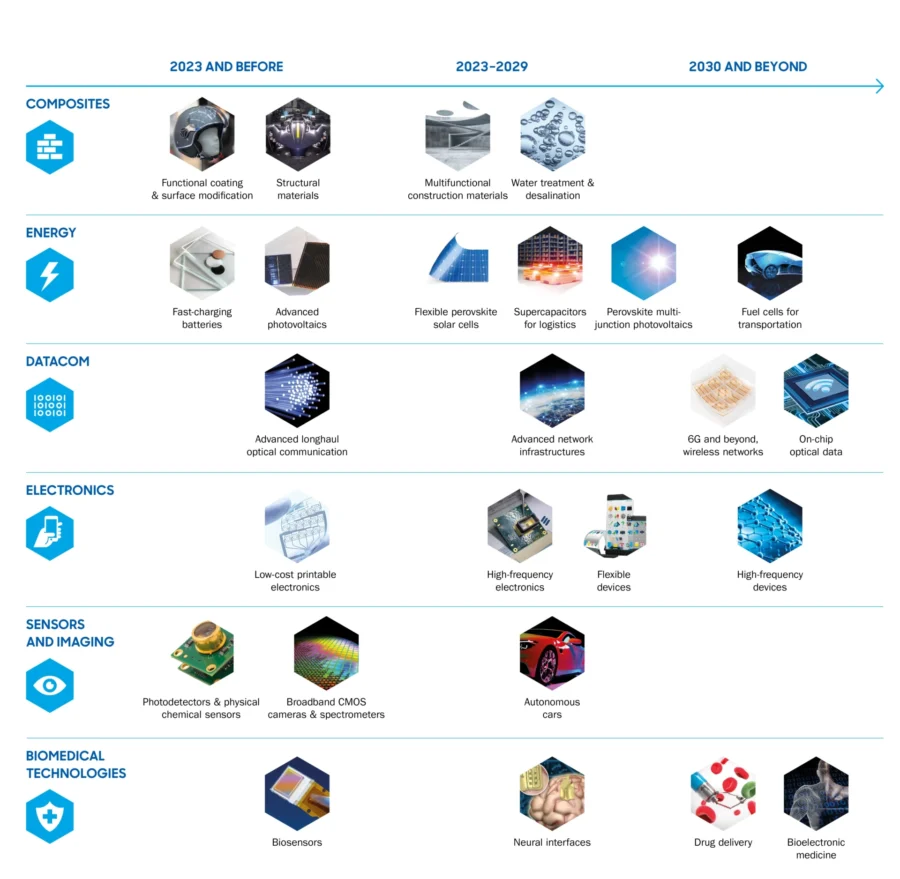
Source: EU Graphene Flagship
Prices for graphene have dropped from 2022’s USD 85/kg median price to a projected USD 40/kg by 2028.
LONGi and Jinko have each topped 33% efficiency in large-area tandem cells, and are going toward Gigawatt-scale production. Additionally, SolaEon announced 31.38% conversion efficiency for its all-perovskite tandem solar cells, and Fraunhofer ISE developed a 31.6% efficient perovskite-silicon tandem cell using a textured silicon surface.
FDA pipelines also show a steady rise in nano-formulated drugs. Lipid-based carriers now enable market-approved siRNA and mRNA therapies along with vaccines.
Further, GDI is commissioning pilot lines that promise 30% higher energy density and 15-minute EV charging.
Financial Forecast
- 2028:
- Annual global graphene demand is projected to reach 9000-170 000 tons.
- 2030:
- The nanotechnology market is expected to reach USD 36.85 billion in market value at a 33.1% CAGR.
- The nanomedicine market alone is projected to grow at a 11.6% CAGR and reach nearly USD 410 billion.
- 2032:
- Market value of quantum-dot displays will increase at a CAGR of 13.6% to reach USD 12.5 billion.
- 2035:
- A 2025 IDTechEx research forecast the market for silicon anodes to exceed USD 15 billion by 2035. This will be driven by demand for higher energy density and faster charging batteries.
Core Technologies Connected to Nanotech
- Advanced Lithography & Deposition: Extreme ultraviolet (EUV) lithography and atomic-layer deposition (ALD) enable 2 nm nanosheets and conformal coating of high-aspect features to sustain semiconductor scaling.
- AI-driven Materials Discovery: Machine learning platforms reduce nanomaterial discovery cycles from years to months. This accelerates graphene, MXene, and perovskite optimization.
- High-Resolution Characterization: Cryo-TEM and in-situ synchrotron X-ray microscopy reveal atomic defects and growth kinetics. This guides quality control for mass production.
- Scalable Nano-Manufacturing: Roll-to-roll printing and chemical vapor deposition (CVD) reactors transition lab-scale nanomaterials to ton-scale output for composites, displays, and battery electrodes.
- Regulatory & Safety Frameworks: FDA nanotechnology guidance and ISO TC229 standards harmonize testing and speed up approvals while safeguarding workers and consumers.
Spotlighting an Innovator: BrasNano
BrasNano is a Brazilian company that offers sintered permanent magnets, a graphene oxide and silver nanoparticle nanocomposite, and a smart coating. The magnets feature anti-corrosion properties by adding reduced graphene oxide during mechanical milling.
Further, the nanocomposite modifies synthetic or natural yarns and fabrics with anti-odor properties and enhanced thermo-physiological comfort. The smart coating provides anti-corrosion and anti-wear protection for automotive suspension systems using graphene oxide.
9. Synthetic Biology & Bio-engineering: A 149 B Market
While venture capital recouped to USD 12.2 billion in 2024 amid a difficult capital market, the global synthetic biology market is expected to reach USD 192.95 billion by 2034 (28.6% CAGR).
While CRISPR Medicine News monitors approximately 250 clinical trials involving gene-editing therapeutic candidates, the first CRISPR-based therapy (Casgevy) has cleared the US FDA and UK NHS obstacles. Further, AI tools (like AlphaFold 3) now predict complete molecular interaction networks with greater accuracy than previous models.
With the introduction of the European Biotech Act and billions set aside for scaleup infrastructure in the US bioeconomy strategy, governments are racing to secure biomanufacturing capacity.
According to the EU Joint Research Centre (JRC) and the Global Biofoundries Alliance (GBA), the EU has a competitive number of publicly funded biofoundries to that of the US and China, although their counts differ. The JRC lists four in the EU, and four each in the US and China, whilst the GBA has 35 publicly funded biofoundries as members globally, of which six are from the EU and US, respectively.
The EU Joint Research Centre notes that only 4 of these are in the EU, compared with 4 each in the US and China. This highlights regional capacity gaps.
Further, South Korea will invest KRW 126.3 billion between 2025-2029 to build national biofoundry infrastructure, while the NSF-led Global Centers awards committed nearly USD 82 million in 2024 to international biofoundry standardization and scaleup projects.
Industry Adoption & Economic Impact
The FDA’s approval of Casgevy, the first CRISPR/Cas9 treatment for sickle-cell disease, is raising the bar for reimbursement across the gene editing market.
Simplified regulations and specialized funding mechanisms, part of the European Commission’s 2024 proposal, boost biotechnology and biomanufacturing. Additionally, the European Parliament supported a comprehensive EU Biotech Act in 2025.
The industry brought in USD 12.2 billion in venture capital last year after a cyclical downturn. According to OECD Science, Technology and Industry Working Papers 2025/03, global venture investment in synthetic biology topped USD 20 billion during the COVID-19 period.
Further, design-to-build times have been shortened from months to days with continuous-flow DNA synthesis and modular biofoundries. For example, AlphaFold 3 predicts protein-DNA/RNA-ligand complexes with double the prior accuracy and reduces hit-to-lead cycles in drug discovery.
Latest commercial cell-free protein synthesis systems also deliver increased yields. They enable on-demand enzyme production without live cells and reduce upstream lead time. Further, new modular closed systems are projected to lower autologous CAR-T manufacturing costs.
Financial Forecast
- 2025-2026:
- Despite a 31% year-on-year dip, 2023 still saw USD 6.9 billion invested, and insiders expect renewed IPO windows as the first gene-editing revenues hit P&L statements in the upcoming years.

Source: BCG/Synonym Report, Feb 2024
- 2034:
- Precedence Research predicts the synthetic biology market to reach USD 192.95 billion (28.63% CAGR). Another estimate places the 2034 value near USD 80.7 billion under conservative scenarios.
- Conservative estimates place the market value near USD 80.7 billion.
Core Technologies Connected to Synthetic Biology
- AI-driven Protein & Pathway Design: DeepMind’s AlphaFold 3 and other generative models speed up enzyme optimisation and de-risk metabolic engineering.
- High-Throughput DNA Synthesis & Foundries: Next-gen chip-based synthesis produces millions of oligos per run, while automated biofoundries iterate thousands of designs per week to speed up R&D cycles.
- CRISPR, Prime & Base Editing Toolkits: Precisely rewrite genomes across plants, microbes, and human cells.
- Cell-Free & Continuous Bioprocessing: Removes cell-growth constraints to enable rapid, on-demand biosynthesis for therapeutics and specialty chemicals.
- Policy & Biosecurity Frameworks: EU Biotech Act initiatives and US bioeconomy roadmaps standardize safety, data-sharing, and scale-up funding. This catalyzes regional manufacturing hubs.
Spotlighting an Innovator: MEATOLOGIC
MEATOLOGIC is an Israeli startup that develops a cost-effective and scalable process for cell-based food production. The company utilizes proprietary tools to improve cell growth and performance for meat production. Moreover, the cultivated cells utilize biosensors to navigate the dynamic meat production process.
Further, the startup’s technology facilitates optimal control of gene regulation to ensure FDA compliance and facilitate a stable and reproducible production process. These features allow food companies to integrate cell-based products without high development costs, while accelerating the product to market.
10. 6G & Next-Generation Connectivity: Terabit-Class Networks
Emerging connectivity technologies deliver microsecond-level latencies, centimeter-grade location, and terabit-per-second data rates.
The race to standardize and monetize emerging connectivity has already started. This is evidenced by the International Telecommunication Union’s designation of 6G as the “IMT-2030” family and the opening of a formal window for candidate radio technology.
6G builds on today’s 5G Advanced to create a completely AI-native, ultra-secure, energy-elastic network fabric. It integrates ubiquitous machine vision, digital twin automation, and real-time holography into everyday tasks.
Growing from 5G to 6G
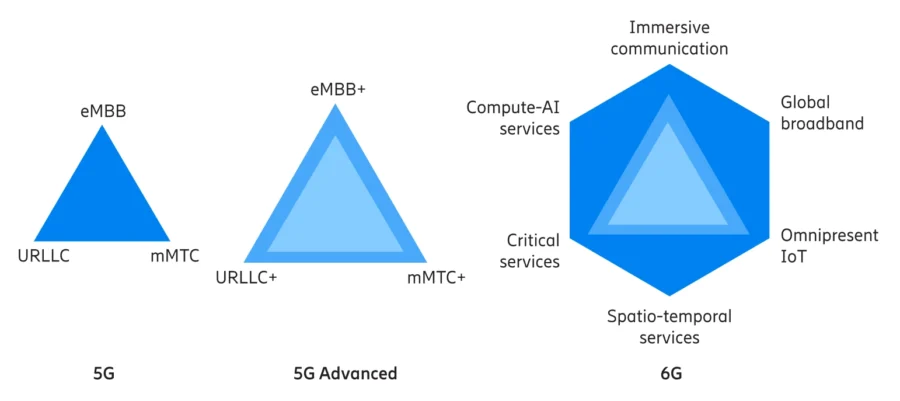
Source: 6G spectrum Whitepaper, Ericsson
Intelligent surfaces, cell-free massive MIMO, space-air-ground integration, and terahertz and upper-mid-band spectrum provide better throughput. That too at a fraction of the latency of 5G, while halving per-bit energy consumption.
Samsung’s 2025 6G white paper outlines directions for AI-native and sustainable communication architecture. This reduces power consumption compared to static techniques.
Further, vendors demonstrated network slicing that reserved guaranteed bandwidth for industrial digital twin traffic at Mobile World Congress 2025, and they had 6G proof-of-concept radios that give peak rates beyond 3 Gbps today and roadmap targets of 1 Tbps in the long term.
Recent terahertz breakthroughs include NTT’s world-record 280 Gbps in the 300 GHz band and China’s 84 Gbps at 220 GHz over 1.26 km for real-time 8K video. Additionally, the University College London achieved 938 Gbps across 5-150 GHz, which is 9000x faster than average 5G speeds.
Industry Adoption & Economic Impact
The 3GPP study work on 6G began with Release 20 in June 2025, and normative specifications will start in Release 21. It will put the first commercial networks on track for the turn of the decade.
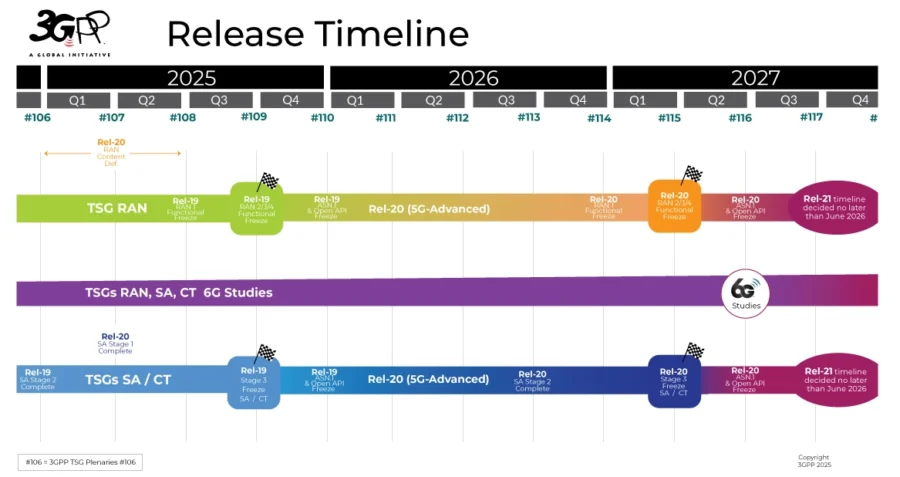
Source: 3GPP
The EU is investing more than EUR 500 million to boost 6G research and innovation. It includes the Hexa-X-II project that creates a 6G platform for reliable and sustainable networks.
The geopolitical stakes are further raised as China (now controlling about 40.3% of 6G patent filings) linked its most recent Five-Year Plan to the goal of early-stage 6G trials by 2026.
Meanwhile, non-terrestrial networks – LEO satellites and HAPS platforms now standardised in 3GPP Releases 17-18 – are being positioned as native components of 6G so that coverage extends from factory floor to polar sea lane.
Further, the EU Smart Networks and Services Joint Undertaking (SNS JU) manages a EUR 900 million budget for 2021-2027 to drive research into 6G technology. To date, it has funded 79 projects with EUR 500 million in EU grants.
Financial Forecast
- 2030:
- Dell’Oro Group estimates cumulative radio-access-network (RAN) revenue will exceed USD 0.4 trillion between 2020 and 2030. It expects macro-RAN upgrades to dominate the first 6G wave.
- 2035:
- Market projections for dedicated 6G products range widely – from USD 69.3 billion to USD 800 billion – yet even the lowest forecasts imply a multi-hundred-percent expansion over mature 5G infrastructure revenues.
Core Technologies Connected to 6G & Other Technologies
- AI-native Network Management: Enables real-time resource allocation and self-healing to drive both energy efficiency and service assurance at a massive scale.
- Open & Cloud-native RAN Architectures: Decouple hardware from software to accelerate innovation cycles and vendor diversity critical to 6G economics.
- Non-Terrestrial Networks: Integrate satellites and HAPS directly into the 3GPP core to ensure global reach for maritime logistics, remote mining, and disaster recovery.
- Reconfigurable Intelligent Surfaces (RIS): Programmable surfaces that manipulate electromagnetic waves to optimize coverage, reduce dead zones, and enhance energy efficiency.
Spotlighting an Innovator: Visban
Visban is a Japanese company that builds RF-on-Glass technology, its RF systems-on-glass that deliver high signal quality with minimal interference and loss. This enhances the efficiency and reliability of mmWave networks.
The RF-on-Glass devices further connect to form the backbone of V-Mesh, a subnetwork that extends and expands the range of mmWave signals between base stations and user devices. V-Mesh automatically reconfigures the subnetwork as necessary to ensure peak performance and connectivity.
Further, the startup’s AI adapts to changing network demands to optimize network performance and route signals around obstacles and congestion. These products allow service providers and organizations to deliver highly reliable mmWave connectivity.
Impact of Broad Technology Domains on 43 Industries Globally

Table of Contents
Emerging technologies, once part of science fiction, are now at the heart of everyday applications, streamlining operations and unlocking new potentials. In this section, we take a deeper look into the tangible ways these technologies. We’ll explore how they are revolutionizing sectors – be it heavy industries with their large-scale operations or service industries that define modern consumer experiences.
Impact of Emerging Technologies on Heavy Industries
In a world where innovation continually redefines the norm, heavy industries are not exempt from the transformative wave of disruptive technologies. From the sprawling fields of manufacturing to the precise nature of aerospace, technological advances are shaping the way we produce, construct, and operate.
Let’s explore how modern tools and methodologies are sculpting a new era for these vital sectors.
Manufacturing
- 3D Printing: enables rapid prototyping and on-demand production to reduce waste and inventory.
- IoT: allows real-time equipment monitoring and predictive maintenance for improved asset management, enabling smart factories.
- AI & ML: provides automated quality assurance and process optimization to increase production efficiency.
Construction
- Augmented Reality: enhances on-site visualization to accelerate project planning.
- Drones: improve site inspection and topographical mapping for project tracking.
- Robotics: automates labor-intensive tasks to enhance precision and worker safety.
Oil and Gas
- IoT: enables pipeline and refinery monitoring in real-time to enhance visibility.
- Blockchain: empowers secure and transparent transaction trails for increased efficiency.
- Nanotechnology: improves extraction processes and enables advanced materials for better petroleum processing.
Utilities
- Smart Grids: ensure efficient and responsive electricity distribution through interconnected systems.
- AI: improves predictive maintenance and demand forecasting accuracy to optimize energy production.
- Cloud Computing: enables centralized data management to improve data access and analytics capabilities.
Automotive
- AI & ML: drive the advancements in autonomous driving and elevate safety features to enhance road safety.
- Additive Manufacturing: streamlines rapid prototyping and accelerates spare parts production, aiding product development.
- IoT: facilitates vehicle-to-vehicle (V2V) and vehicle-to-everything (V2X) communication to optimize traffic flow.
Mining
- Advanced Robotics: replaces humans for exploration in deep-sea and hazardous environments.
- Big Data: delves into geological and operational data to identify promising exploration sites and optimize processes.
- Drones: conduct aerial surveys and map sites from a bird’s-eye view to improve operational visibility.
Energy
- AI: fine-tunes energy distribution and maximizes storage efficiency by advancing energy analytics.
- Blockchain: offers a transparent platform for peer-to-peer (P2P) energy trading, aiding decentralized energy production.
- Nanotechnology: boosts battery storage capacities for prolonged energy retention.
Steel
- 3D Printing: fabricates intricate steel components to accelerate product development while minimizing material waste
- IoT: oversees and refines furnace operations in real-time through remote monitoring to avoid operational disruptions.
- Cloud Computing: enhances supply chain and inventory management efficiency by centralizing data.
Aerospace
- Advanced Robotics: ensures precision in assembly and rigorous quality control required for aerospace equipment.
- AR & VR: modernize pilot training and offer immersive aircraft maintenance simulations to improve safety.
- Nanotechnology: crafts lightweight materials to create flight bodies and increase fuel efficiency.
Railroad
- IoT: provides real-time insights into rail conditions and traffic to improve infrastructure health and traveler safety.
- AI & ML: forecast maintenance needs for locomotives to prevent breakdowns and improve data analytics.
- Augmented Reality: enables assisted maintenance for efficient on-field repairs and streamlines maintenance tasks.
Shipbuilding
- Advanced Robotics: revolutionizes tasks like welding and heavy lifting to improve production efficiency.
- 3D Printing: tailors the manufacturing of intricate components on-demand and ensures timely spare parts supply.
- IoT: monitors ship health and calibrates optimal maritime routes in real-time, enhancing ship safety.
Impact of Emerging Technologies on Process Industries
Process industries are known for their role in the production of necessities like chemicals, pharmaceuticals, and food products. These sectors, integral to the backbone of global supply chains, are characterized by complex and large-scale production processes.
As such, they are prime candidates for the integration of emerging technologies. From AI optimizing production lines to IoT devices ensuring real-time monitoring and quality control, the impact of these technologies is far-reaching. Explore how these advancements are streamlining operations and catalyzing a new era in the process industries.
Food & Beverage
- IoT: ensures freshness of food products through real-time monitoring of storage conditions.
- Blockchain: increases ingredient traceability from farm to table with tamper-proof data storage.
- AI & ML: analyzes customer tastes and preferences to guide product development.
Chemical
- Nanotechnology: innovates with new materials and catalysts for enhancing production and delivering high-performance applications.
- Big Data & Analytics: uses advanced models to analyze material and production data to optimize reaction outcomes and ensure optimal conditions.
- IoT: safely monitors and controls chemical processes to ensure high-quality production processes.
Pharmaceuticals
- AI & ML: accelerate drug discovery and craft personalized medicine formulations.
- Blockchain: secures transparent supply chains for medication distribution and counterfeit risk mitigation.
- Advanced Robotics: ensures precision in drug synthesis and packaging, delivering high quality in production.
Materials
- Nanotechnology: enhances material properties at the atomic level to expand use cases.
- 3D Printing: facilitates rapid prototyping and testing of novel materials for faster time-to-market.
- IoT: observes material behaviors under diverse conditions to accelerate material design.
Textiles
- AI: forecasts emerging fashion trends and discerns consumer inclinations to ensure a competitive edge.
- Nanotechnology: engineers wear-resistant fabrics and smart wearables that prioritize wearer comfort.
- IoT: promotes sustainable resource utilization during production through real-time process and equipment monitoring.
Semiconductor
- Advanced Robotics: achieves ultra-precision during chip manufacturing to deliver cutting-edge electronics.
- AI & ML: detect faults and maintain stringent quality control throughout the manufacturing process.
- Nanotechnology: pioneers the creation of smaller, more efficient chips for high-performance applications.
Cosmetics
- AI: customizes product recommendations after thorough skin analysis.
- Nanotechnology: refines product formulations for enhanced skin absorption.
- Blockchain: verifies the ethical sourcing of ingredients and increases supply chain transparency.
Water & Wastewater Management
- IoT: monitors water quality and infrastructure in real-time for optimizing processes and resource utilization.
- AI & ML: foresees and manages water usage patterns to identify water-saving opportunities.
- Nanotechnology: enables advanced techniques for water filtration and purification, tackling global water shortage.
Impact of Emerging Technologies on Light Industries
The world of light industries, often associated with everyday products and consumer goods, is undergoing a silent yet profound revolution. These sectors, while differing vastly in products, share a common thread: they cater directly to end consumers.
Thus, the stakes are high for innovation, customization, and efficiency. Dive into the myriad ways emerging technologies in businesses are reimagining the fabric of these industries.
Apparel
- AI: provides customized fashion suggestions and facilitates virtual try-ons.
- 3D Printing: accelerates prototyping of innovative fashion accessories, enabling faster development cycles.
- IoT: integrates sensors into smart clothing to simplify health monitoring and they also track manufacturing processes.
Publishing and Printing
- Augmented Reality: enhances print media with interactive experiences for increased audience engagement.
- Blockchain: ensures secure content distribution and robust digital rights management for businesses.
- AI & ML: automate content curation while tailoring content to personal preferences and improving processes.
Consumer Electronics
- IoT: interlinks devices to create a unified smart home environment, thereby enhancing customer experiences.
- AR & VR: are shaping the future of immersive gaming, content consumption, and even online shopping.
- AI: curates personalized user interactions and supports voice-command operations to improve customer engagement.
Medical Devices
- Advanced Robotics: offers precision tools for remote and intricate surgeries, increasing patient safety.
- IoT: facilitates remote patient surveillance by providing real-time health data and thus enabling timely interventions.
- AI & ML: delivers predictive health evaluations based on medical device metrics for prompt medical interventions.
Furniture Manufacturing
- Augmented Reality: provides virtual furniture placements within actual spaces to reduce cart abandonment.
- 3D Printing: crafts customized furniture parts and accessories as well as enables on-demand furniture manufacturing.
- IoT: improves visibility into furniture manufacturing and integrates with furniture to elevate buyer experience.
Leather Goods
- Blockchain: validates the ethical sourcing of leather and enhances supply chain transparency to improve brand trust.
- AI: forecasts design trends and anticipates demand to increase sales.
- Nanotechnology: augments leather with superior durability and resistance to stains, thereby enabling novel product lines.
Jewelry
- 3D Printing: enables tailored jewelry designs and swift prototyping, allowing jewelry brands to make custom designs on demand and quickly.
- AR: offers virtual try-ons and enriches shopping interactions, increasing customer satisfaction.
- Blockchain: certifies the authenticity of gemstones and traces the lineage to improve customer loyalty.
Impact of Emerging Technologies on Service Industries
Service industries, recognized as the pillars of modern economies, are where many individuals directly encounter the benefits of emerging technologies. This arena is marked by its focus on consumer interaction, experience enhancement, and efficient service delivery.
In this rapidly evolving environment, emerging technology acts as both a disruptor and an enabler. Let’s explore how these innovations in technology are crafting a renewed vision for each sector within the service industries.
Retail and eCommerce
- AI: offers personalized shopping journeys and product suggestions to increase conversion for brands.
- Augmented Reality: facilitates virtual try-ons and delivers immersive product displays for enhanced customer interactions.
- Blockchain: guarantees transparent supply chains and validates product authenticity by leveraging tamper-free data storage.
Finance
- Blockchain: provides secure transactions, enforces smart contracts, and enables decentralized finance (DeFi).
- AI & ML: detect fraud, aid in risk mitigation, provide investment perspectives, and advance anti-money laundering (AML).
- Cloud Computing: centralizes financial data to increase efficiency and streamline operations.
Logistics
- IoT: provides real-time shipment monitoring and adept inventory oversight for improved decision-making.
- AI: enables predictive analytics for optimal routing and demand anticipation, thereby streamlining resource utilization.
- Blockchain: ensures secure and transparent documentation and contractual agreements to increase compliance adherence and customer trust.
Tourism and Hospitality
- Augmented Reality: showcases interactive tours with detailed overlays to enhance the traveler experience.
- AI: curates personalized travel agendas and delivers virtual concierge assistance, thereby increasing traveler engagement.
- IoT: crafts intelligent hotel spaces tailored for individual guest experiences.
Transportation
- IoT: connects vehicles and sophisticated traffic control systems to manage traffic in real-time and improve road safety.
- AI & ML: advise on predictive upkeep and real-time travel route enhancement, mitigating traffic congestion.
- Blockchain: secures ticketing processes and offers transparent fare structures for improving the commuter experience.
Real Estate
- Augmented Reality: presents virtual property expeditions and intuitive layout visualizations to deliver enhanced buyer experiences.
- Blockchain: affirms transparent property exchanges and precise ownership archives to increase buyer confidence and, in turn, sales.
- AI: analyzes market predictions and evaluates property worth to drive decision-making for real estate investments.
Healthcare
- AI & ML: assists in disease diagnosis, strategizes treatments, and oversees patient health to deliver high-quality healthcare.
- IoT: enables connected wearables that provide comprehensive health insights and distant patient care, enabling remote patient monitoring (RPM).
- Blockchain: protects and ensures transparency in patient archives to advance medical research and enable secure and easy access to patient data.
Impact of Emerging Technologies on Interdisciplinary Industries
While many industries can be grouped under broad umbrellas like heavy, process, or service industries, some stand out for their distinct nature and influence. These unique sectors often operate at the intersections of traditional categories, wielding the power to shape everything from our daily lives to global paradigms.
As technology permeates these sectors, it ushers in a blend of innovations tailored to their specific challenges and opportunities. Here, we spotlight five such industries: Agriculture, Biotech, Packaging, Telecom, and Smart Cities, and delve into the transformative power of emerging technologies within them.
Agriculture
- IoT & Connectivity Technologies: allow farmers to optimize crop growth and livestock care, enabling them to leverage precision farming.
- AI & ML: offer insights for pest identification, yield forecasting, and mechanized harvesting – all improving crop and soil management.
- Drones: capture aerial visuals for meticulous crop scrutiny and enable specified pesticide deployment to optimize input application.
Biotechnology
- Nanotechnology: enables targeted drug conveyance mechanisms and refined diagnostics, impacting the pharma and healthcare industries.
- Gene Editing: utilizes CRISPR technology for exact DNA alterations, advancing treatments and investigative studies.
- AI: harvests data-driven discernments for innovative drug discoveries and comprehensive genome mapping.
Packaging
- 3D Printing: pioneers tailored packaging blueprints and accelerated prototyping, enabling cost-effective personalized packages and accelerated product development.
- Nanotechnology: provides intelligent, enduring packaging substrates for packaging companies to make smart packages.
- IoT: enables ingenious packaging strategies that track product freshness and supervise thermal conditions to ensure optimal storage conditions.
Telecom
- 5G and Beyond: amplify connectivity velocities and enable instantaneous data exchanges for data-intensive applications like real-time asset monitoring.
- IoT: interlinks innumerable gadgets, setting the foundation for intelligent metropolises and domiciles.
- Cloud Computing: presents scalable frameworks and utilities while reducing IT burden for the dynamic telecommunication landscape.
Smart Cities
- IoT & Connectivity Technologies: enable interconnected systems spanning traffic, utilities, and public amenities, improving the safety and quality of living.
- Blockchain: promotes transparent governing paradigms and fortified, decentralized databanks to minimize corruption and ensure inclusive governance.
- AI, Big Data, & Analytics: facilitate urban design and upkeep of communal resources as well as enhance instantaneous civic services with real-time analytics.
Challenges and Ethical Considerations: Navigating the Double-Edged Sword of Disruptive Innovation
While these emerging technologies are driving unprecedented advancements, they simultaneously cast shadows of challenges and ethical dilemmas. Like any powerful tool, these technologies, if wielded without care, present risks that might overshadow their immense benefits.
In this section, we dive into the hurdles that stand before us and the ethical quandaries that compel us to ponder the deeper implications of our technological pursuits.
Challenges
- Integration with Existing Systems: Merging new technologies into current systems often demands substantial adjustments and leads to compatibility issues with legacy systems.
- Skill Gap: As newer technologies emerge, there is a growing demand for skilled professionals. Many industries face the challenge of a skill gap where there aren’t enough qualified individuals to handle novel technologies.
- Security Concerns: The growing number of connected devices increases their vulnerability to cyberattacks and data breaches.
- High Initial Costs: Investing in cutting-edge technology requires a significant financial outlay before any return on investment (ROI) is realized.
- Reliability and Maturity: Not all emerging technologies have been tested at scale, leading to concerns about their reliability and long-term viability.
Ethical Considerations
- Data Privacy: As data becomes the new oil, concerns about who has access to this data, and how it is used, become paramount. Ensuring data privacy and informed consent is crucial.
- Bias and Fairness: AI and machine learning models unintentionally perpetuate biases present in their training data, leading to unfair or discriminatory outcomes.
- Transparency and Accountability: With systems making autonomous decisions, ensuring transparency in how they operate and holding them accountable becomes a significant concern.
- Job Displacement: Technological advancements render certain job roles obsolete, leading to economic and social implications.
- Environmental Impact: While many technologies reduce environmental harm, producing and disposing of tech products have detrimental environmental effects.
Emerging technologies, while holding promise for a brighter, more efficient future, come with their set of challenges and ethical dilemmas. Balancing innovation with responsibility will be the key to ensuring that these technologies benefit society at large without compromising on fundamental values and rights.
The Future Outlook for Emerging Technologies
Emerging technologies stand as the vanguard of a new era by enabling novel tools and profound reshaping of industries, societies, and individual lives. Rooted in the convergence of biotech, infotech, cognitive science, quantum mechanics, and nanotech, these technologies are not just incremental enhancements; they are paradigm shifts.
Several themes become evident about the shape and scope of technology of the future:
Ubiquitous Integration
Future technologies won’t stand isolated. They’ll become seamlessly integrated into our daily lives, working in harmony. We’ll see more homes, cars, and entire cities becoming ‘smart’, communicating and operating autonomously to enhance our quality of life.
Hyper-Personalization
Thanks to advances in AI and data analytics, technologies will have a deeper understanding of individual preferences. From healthcare treatments tailored to an individual’s genetic makeup to personalized learning experiences in education, technology will cater to each person’s unique needs and desires.
Sustainable and Ethical Innovations
As environmental and ethical concerns take center stage, future technologies will align more with climate-positive practices. Renewable energy, green transportation, and circular economies will be the pillars of innovation.
Democratization of Technology
Access to technology will become more widespread, breaking down traditional barriers. Innovations in cloud computing and open-source platforms will further ensure that even small enterprises or individuals in remote locations harness the power of high-end technological tools – take ChatGPT and Bard for example.
Emphasis on Human-Machine Collaboration
Rather than replacing humans, future technologies will focus on augmenting human capabilities. Advanced robotics, AI, and augmented reality will work hand-in-hand with humans, leading to symbiotic collaborations where both entities play to their strengths.
Resilience and Security
As our dependence on technology grows, so does the need for robust security measures. Future technologies will not only have to be efficient but also resilient against threats to ensure the safety and security of users and data.
The future, with its amalgamation of challenges and opportunities, beckons us to move forward with hope and caution. As emerging technologies pave the way forward, it’s up to us to harness their potential responsibly and ensure a brighter, more inclusive, and sustainable tomorrow.
To Stay Ahead of the Technology Curve, it’s More Important than ever to be Proactive
As you’ve seen, the technology landscape for 2026 is brimming with potential. To make the most of these opportunities, leverage our AI-powered Discovery Platform, designed to simplify your investment journey with actionable insights.
Here’s how you can get started:
- Access Comprehensive Data: Explore over 7 million startups and 20 000+ emerging technologies and trends across the globe.
- Filter & Compare: Narrow down startups by technology, location, funding, and more, and compare them based on innovation potential and market fit.
- Make Informed Decisions: Analyze detailed startup profiles, including their products, team, funding history, and market position.
- Engage Directly: Connect with startups or request introductions from our expert team.
Stay ahead of the curve by equipping yourself with the insights that matter. Get in touch today to see how our Discovery Platform empowers you to spot trends early, make confident investments, and lead in the fast-evolving tech world.

